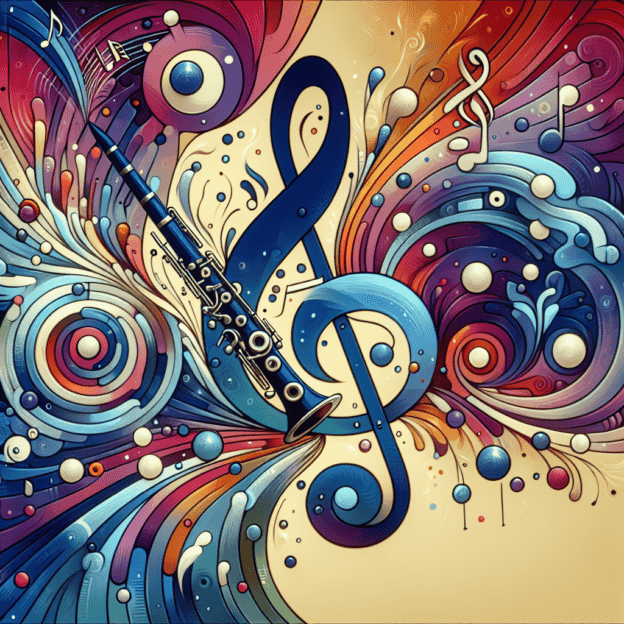The G# Whole-Tone Scale: A Clarinet's Secret Weapon
When we look at how clarinet music has changed over time, the G# Whole-Tone Scale stands out. This scale isn't talked about as much as others, but it's had a big impact on shaping how music sounds. Let's explore its history and how it's influenced clarinet players over the years.

Clarinet Fingering Charts are always FREE at MartinFreres.net!
What is the G# Whole-Tone Scale?
The G# Whole-Tone Scale is special because it's not like regular scales. It's made up of notes that are all a whole step apart, which gives it a dreamy, floaty sound on the clarinet. When you play it, it's like you're taking your listeners on a journey through the clouds! This scale has inspired many composers, from classical guys like Debussy to jazz musicians, to try new things with melodies and harmonies.
The History and Origins
You might be wondering, “Where did this scale come from? Is it just a cool trick or is there more to it?” Well, let's take a trip back in time! Whole-tone scales started becoming popular in the late 1800s, especially with Impressionist composers. Debussy, in particular, loved using these scales in his music. He used them to create a new kind of sound that broke away from the usual ways of making music. The G# Whole-Tone Scale really shines in his work, helping to create that dreamy, flowing style he's famous for.
| Era | Impact of G# Whole-Tone Scale |
|---|---|
| Late 19th Century | Gained popularity with Impressionist composers |
| 20th Century Jazz Era | Used for complex improvisations and solos |
| Modern Film Scoring | Creates haunting, mysterious atmospheres |
The Ripple Effect on Music
But the story doesn't end there! The influence of this scale is like tossing a pebble in a pond – it spreads out to touch many different kinds of music. When we jump ahead to the jazz age in the 1900s, we find musicians using the G# Whole-Tone Scale to make their solos more interesting and unpredictable. By using this scale, they could explore new musical territories and create sounds that were out of this world.
Understanding the G# Whole-Tone Scale
To break it down, the G# Whole-Tone Scale is made up of the notes G#, A#, B#, C#, D#, and E#. It's really important for clarinet players to get how this scale works, not just in theory but also in practice. When you practice this scale, it helps you move your fingers better and can make you better at improvising. It pushes you to think differently about music, which is super important if you want to grow as a musician.
How It's Used in the Real World
Now, let's talk about how this scale is actually used. Many clarinet players have their own special way of using the G# Whole-Tone Scale in their music. Because it sounds so unique, this scale can help create really captivating pieces. Just think about playing a piece by Martin Freres that uses these notes – you'd definitely grab people's attention and create a moment they'd remember!
The G# Whole-Tone Scale in Film Music
This scale is also really powerful in movie music. Picture a spooky melody played on a clarinet – it can instantly make you feel like you're in a mysterious, magical world. Composers use the G# Whole-Tone Scale to make scenes more emotional, creating music that sticks with you long after the movie's over.
How It's Changed Clarinet Music
Over time, clarinet music has gotten richer by trying out new scales like this one. The G# Whole-Tone Scale brings out sounds in the clarinet that other instruments can't quite match. It lets the clarinet dance through the notes in a really elegant way, reimagining how music can sound and feel. This is something that Martin Freres clarinets are known for doing really well.
Wrapping It Up
To sum it all up, the G# Whole-Tone Scale has left its mark on clarinet music in a big way. It started with the Impressionists and has found its way into modern jazz and movie music. Its airy, dreamy quality makes performances more interesting and brings melodies to life, letting musicians express feelings in new ways. By continuing to explore this scale, clarinet players can honor its history while pushing the boundaries of what's possible in music. So why not pick up your clarinet, give the G# Whole-Tone Scale a try, and see where your creativity takes you?
Table of Contents
- The G# Whole-Tone Scale: A Clarinet's Secret Weapon
- What is the G# Whole-Tone Scale?
- The History and Origins
- The Ripple Effect on Music
- Understanding the G# Whole-Tone Scale
- How It's Used in the Real World
- The G# Whole-Tone Scale in Film Music
- How It's Changed Clarinet Music
- Wrapping It Up








